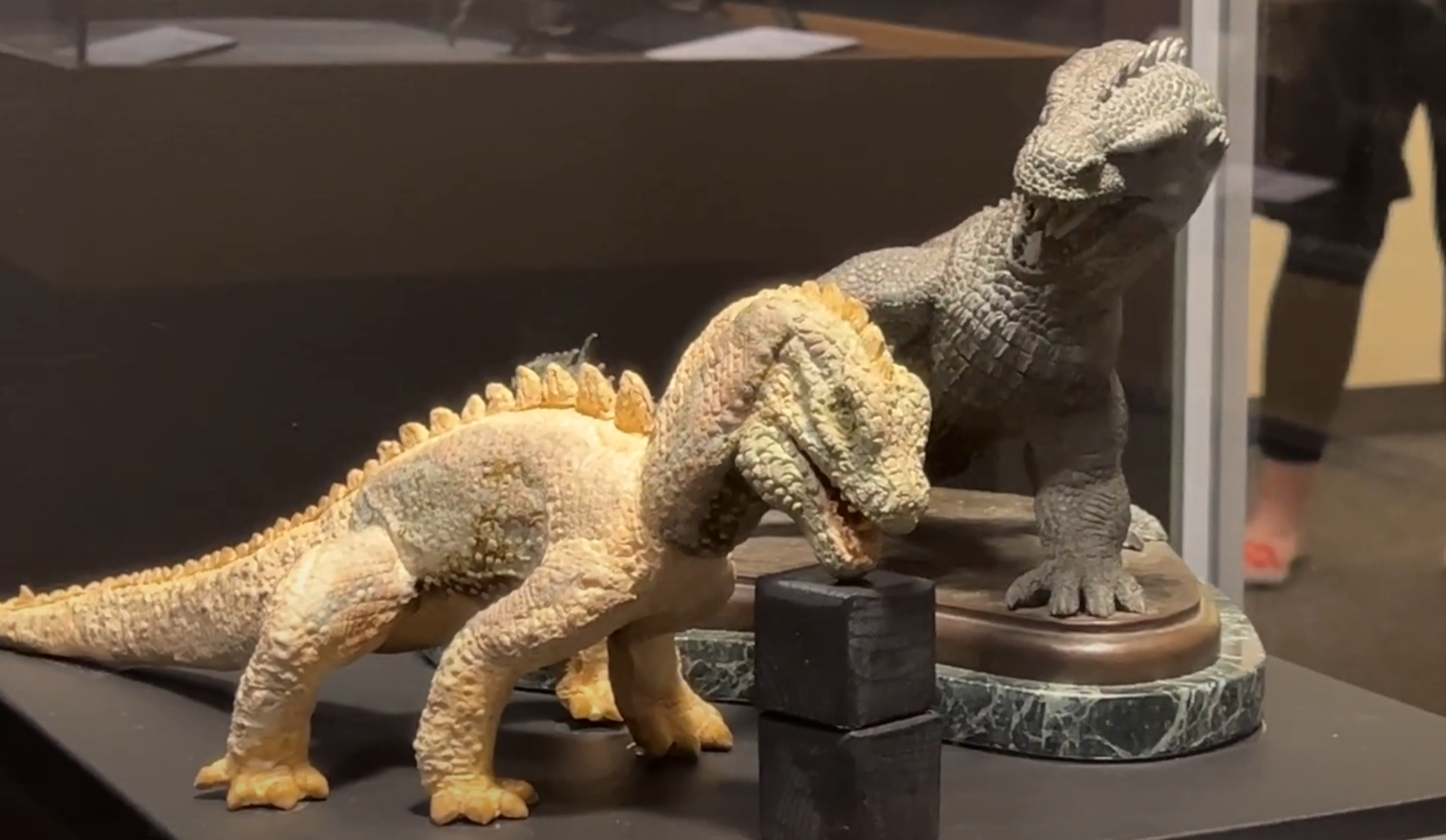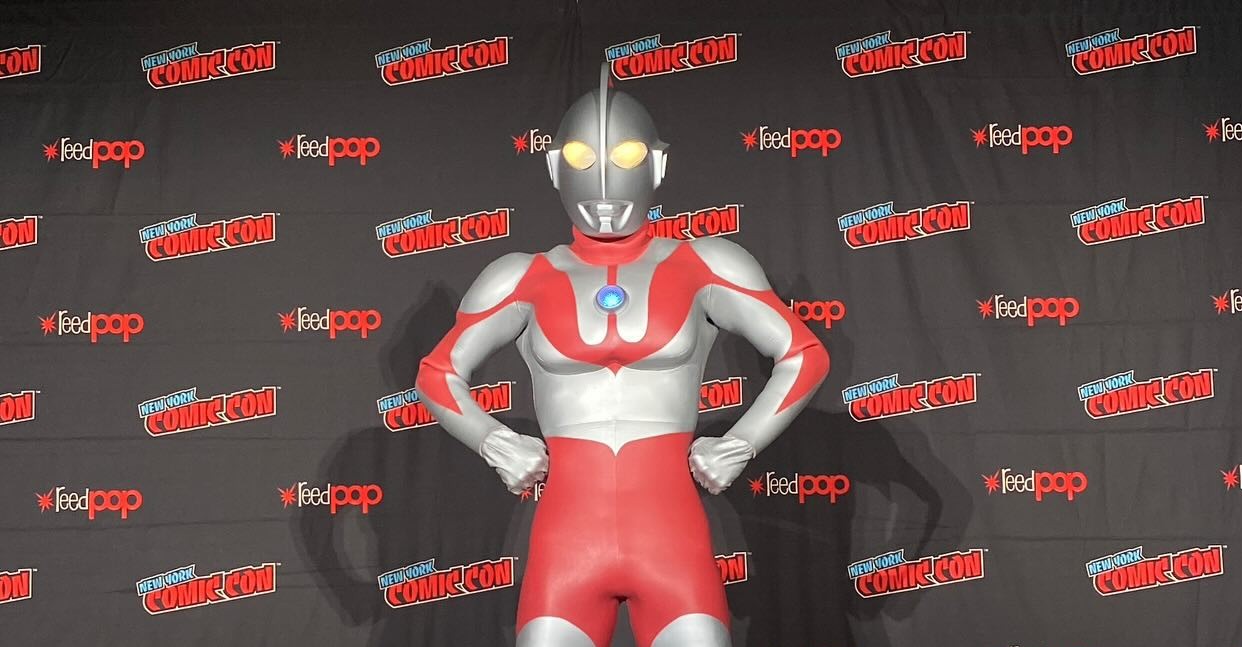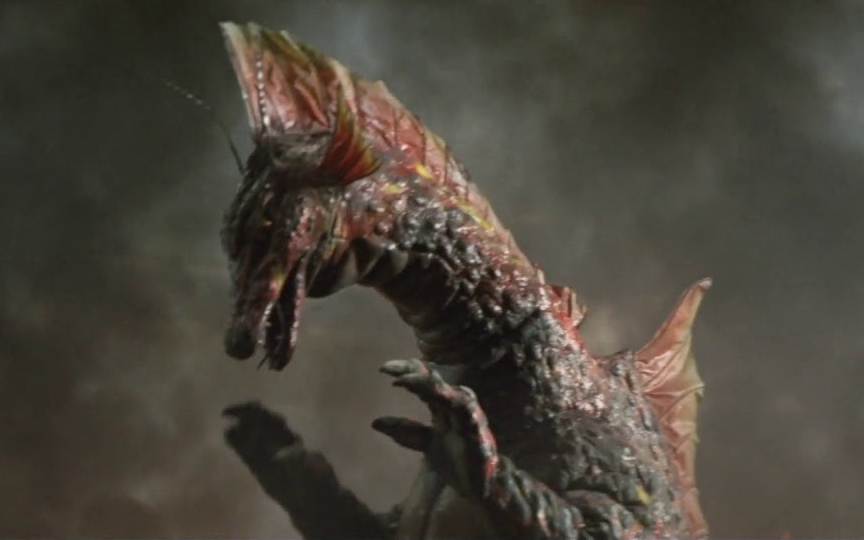“I was thinking of going to the Harryhausen exhibit in Kalamazoo tomorrow and seeing if you wanted to go with me and 3 kids,” read the text message from Nick Adam of The Monster Report. “I know it’s kinda short notice.” When it’s Friday night, your car is mysteriously broken, and you’ve had the lousiest few weeks you’ve had in a while, an offer like this from a fellow Hoosier kaiju fan/content creator can revive you faster than a dying Rodan. (Okay, that was a weird analogy).
So, the next morning, Nick and three of the five members of his family arrived. We drove the next two hours to a Michigan town with a funny name, stopping only once at a trucker gas station that had a sword shop (for real) to see a collection called Ray Harryhausen: Miniature Models of the Silver Screen at the Kalamazoo Valley Museum. This exhibit, which runs until April 27, 2025, showcases over 100 artifacts spanning the multi-decade career of the pioneering stop-motion artist. Harryhausen, who was born June 29, 1920 (which means he shares a birthday with me) worked on 16 feature films from 1949’s Mighty Joe Young, where he collaborated with the OG stopmotion master Willis “Obie” O’Brien of King Kong fame, to 1981’s Clash of the Titans. He took what O’Brien started and perfected it, paving the way for the likes of Phil Tippett and Stan Winston.
According to the museum’s website:
“Since Ray’s death on May 7, 2013, and the acquisition of his collection by The Ray & Diana Harryhausen Foundation, the Trustees have been committed to continuing Ray’s hopes for the future, as well as protecting and conserving his name and unique contribution to world film history. It is estimated that there are in excess of 50,000 items in the collection, including original armatures and armatured models, hard rubber stand- in models, original molds and miniatures, original artwork, stills, negatives, screenplays, and various test and dailies footage.”
Nick, his kids, and I spent over an hour exploring all of these pieces of cinema history. As I’ve done since childhood, I read every plaque and soaked it all in like a nerdy sponge. It helped that the exhibit was confined to one room; it only housed 100 of the 50,000 artifacts from the collection, after all. It would take an entire dedicated museum to house everything, which needs to happen. We then, being content creators, seized the opportunity to record videos and commentaries on several of the items on display.
Harryhausen’s first film, as I mentioned, was technically 1949’s Mighty Joe Young (he was uncredited on this film), and I got to see a replica of Joseph Young himself—or as Ray called him, “Jennifer.” That was his nickname for the smaller of the two armatures he used to bring the titular character to life. As much as Ray admired Obie’s work on King Kong, he found the titular ape’s movements to be a bit too unnatural, so he sought to do something even better with Mighty Joe. The replica at the museum was created by Jeff Taylor from 8th Wonder Studio and shows the “skeleton” of ball joints and other innovations that helped Harryhausen give Joe such personality. It was like seeing a wireframe for a CGI character, only it was real.

(Photo by Nathan Marchand)

(Photo by Nathan Marchand)
Harryhausen’s breakthrough film was 1953’s The Beast from 20,000 Fathoms, which was inspired by a short story titled The Foghorn, written by Ray’s best friend, Ray Bradbury. It was not only the first atomic age monster movie, it was the first time Harryhausen’s name was credited as special effects technician. Famously, seeing this largely inspired Toho producer Tomoyuki Tanaka to transform a failed film project into what would eventually become Godzilla (1954). In other words, without Harryhausen, we wouldn’t have Big G. I bring this up because the exhibit featured a prototype rubber model of the Rhedosaurus (circa 1952) and a bronze and marble sculpture of the “Beast” (circa 1985), both molded by Harryhausen. I joked that these two looked like a pair of brothers bickering over snacks.

marble sculpture of the Rhedosaurus (circa 1985), the titular creature from the iconic The Beast from 20,000 Fathoms. The lighthouse model the creature destroys was also on display. (Photo by Nathan Marchand)
Another highlight at the exhibit was a model of the Ymir, the monster featured in Nick Adam’s favorite Harryhausen film, 20 Million Miles to Earth. This model was created by Ray in 1990. This creature, a term Harryhausen preferred over “monsters” for his creations, is among Ray’s most tragic. He was brought to Earth from his native Venus and goes on a rampage not out of malice but out of confusion. 20 Million Miles has homages in several later films, with the most recent being Godzilla sleeping like a cat in the Roman Coliseum in Godzilla x Kong: The New Empire. The Ymir climbs to the top of said Coliseum during 20 Million Miles’s climax. Harryhausen notoriously suggested this setting just so he could take a vacation in Italy.

Harryhausen in 1990. This iconic creature is among Ray’s most tragic, but he’s been homage in several films since then.
(Photo by Nathan Marchand)
While The 7th Voyage of Sinbad is well-regarded, some forget that Harryhausen made two more films in the 1970s starring that adventurous sailor, starting with The Golden Voyage of Sinbad (1973). In the short video Nick cut together for this article, you’ll see the model of the six-armed goddess of death Kali, who danced in response to her worshippers and fought Sinbad, a la the skeleton from Jason. Ray brought in real dancers to watch so he could choreograph the goddess’ movements. That creature certainly paved the way for the likes of Medusa almost a decade later. Four years later in 1977, Harryhausen would co-write and produce Sinbad and the Eye of the Tiger (cue the Survivor song) as well as create the special effects, and several items from that lesser-known entry in Ray’s filmography were at the exhibit. This included a replica of one of the ghouls, which were recycled models from the famous skeleton scene in Jason and the Argonauts. (The ghouls look suspiciously like Kamen Rider to me).
There was also a latex/resin model of the giant walrus that attacks Sinbad and his merry band of sailors, proving that Maguma was desperate for work in the ‘70s. Finally, there was a copy of the model of the Minaton as well as the props for its hand crank and heart. Eye of the Tiger is a strange blending of Arabic folklore and Greek mythology, and that’s quite obvious even in this exhibit.

(Photo by Nathan Marchand)

(Photo by Nathan Marchand)
Harryhausen’s last hurrah before retirement was 1981’s Clash of the Titans, which is a retelling of the Perseus myth and has some of his finest work, so the exhibit showcased several items from it. One such artifact was a model of the iconic snake-haired Medusa created by Ray in 1979. How he had the skill and, more importantly, patience to animate all the tiny serpents on her head is beyond me. Also included in the exhibit were two models created in 1979 of the wonderful Bubo, the mechanical owl sidekick to Perseus. He may scream, “Toyetic!” but who wouldn’t want this littler automaton as a friend? Finally, there was quite possibly the biggest artifact at the exhibit: a model created in 1980 of the Kraken, which looked to be a good three feet long from head to fish tail. It definitely looks like a “descendent” of the Ymir.

(Photo by Nathan Marchand)

(Photo by Nathan Marchand)

(Photo by Nathan Marchand)
Ray Harryhausen’s legacy is one of imagination and craftsmanship. Nowadays, most special effects are created inside of computers using mice and keyboards. Ray got his hands dirty, figuratively and literally, to bring his wondrous creatures to life. He’s a testament to patience, determination, and creativity. They don’t make men (or monsters) like that anymore.

If you’d like to hear more about the exhibit, Nick is producing a longer video highlighting the exhibit for The Monster Report YouTube channel, and then we’ll host a livestream about it on the YouTube channel for my podcast, The Monster Island Film Vault.






